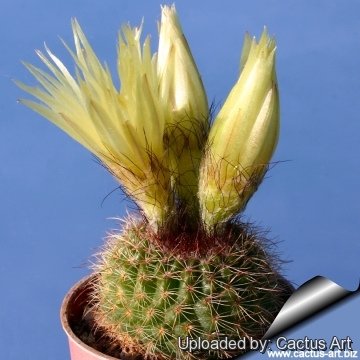




Your support is critical to our success.
Accepted Scientific Name: Parodia werdermanniana (Herter) N.P.Taylor
Bradleya 5: 93. 1987

Origin and Habitat: Uruguay and Rio Grande do Sul, Brazil
Synonyms:
- Parodia ferruginea (H.Schloss.)
- Notocactus ferrugineus H.Schloss.
- Notocactus werdermannianus f. ferrugineus (H.Schloss.) N.Gerloff & Neduchal
Parodia werdermanniana (Herter) N.P.Taylor
Bradleya 5: 93. 1987
Synonymy: 27
- Parodia werdermanniana (Herter) N.P.Taylor
- Notocactus werdermannianus Herter
- Peronocactus werdermannianus (Herter) Doweld
- Wigginsia werdermanniana (Herter) Doweld
- Parodia ferruginea (H.Schloss.)
- Notocactus ferrugineus H.Schloss.
- Notocactus werdermannianus f. ferrugineus (H.Schloss.) N.Gerloff & Neduchal
- Parodia memoralis (Prestlé)
- Notocactus memoralis Prestlé
- Parodia vanvlietii (Rausch)
- Notocactus vanvlietii Rausch
- Parodia vanvlietii var. antoniana
- Parodia werdermanniana var. brunneispina
- Parodia werdermanniana var. caespitosa
- Parodia werdermanniana var. concinnioides
- Parodia werdermanniana f. cristata hort.
- Parodia werdermanniana f. grandiflora
- Parodia werdermanniana var. liliputana
- Parodia werdermanniana f. monstruosa hort.
Description: Parodia ferrugineaSN|16481]]SN|16485]] (best known as Notocactus ferrugineusSN|16486]]SN|16486]]) is one of the morphological or local forms of the variable Parodia werdermannianaSN|16481]]SN|16481]] from Uruguay and Brazil. True to its name, it has distinguishing rusty red bristly spines. With the exception of the spination, all the other characteristics are absolutely identical with standard Parodia werdermannianaSN|16485]]SN|16481]], namely size and form of stems, number of spines, size and colour of flowers. The flowers, like in other varieties, are very showy, bright pink or purple up to 12 cm in diameter.
Habit: Plants usually solitary. Multiple branches may also been produced when the apex is damaged.
Stem: Spherical to club shaped, yellow-green, slightly depressed apically, to 13 cm high and 10 cm in diameter.
Ribs: Numerous (up to 40), straight, low, with many fairly large chinlike humps below the areoles.
Spines: Thin needle-like or bridtly, rusty-red or or brownish turning grey as they age.
Central spines: 4, cross shaped up to15 mm long.
Radial spines: 10-20 adpressed or more or less erect, to 5 mm long.
Flowers: 6 or more produced together around the stems apex, sulfur yellow, to 6 cm long and 7 cm in diameter.
Seeds: With a distinctive longitudinally-oriented fine striate cuticular sculpturing.
Subspecies, varieties, forms and cultivars of plants belonging to the Parodia werdermanniana group
 Parodia ferruginea (H.Schloss.): has distinguishing rusty red spines. With the exception of the spines, all the other characteristics are identical with standard Parodia werdermanniana. Distribution: Uruguay and Rio Grande do Sul, Brazil.
Parodia ferruginea (H.Schloss.): has distinguishing rusty red spines. With the exception of the spines, all the other characteristics are identical with standard Parodia werdermanniana. Distribution: Uruguay and Rio Grande do Sul, Brazil. Parodia werdermanniana (Herter) N.P.Taylor: Has up to 40 ribswith chinlike humps below the areoles, 4 central spines (usually yellowish, but also reddish or brownish) and 5-merous (10-20) yellowish white radials. Distribution: Tacuarembó, Uruguay.
Parodia werdermanniana (Herter) N.P.Taylor: Has up to 40 ribswith chinlike humps below the areoles, 4 central spines (usually yellowish, but also reddish or brownish) and 5-merous (10-20) yellowish white radials. Distribution: Tacuarembó, Uruguay.- Parodia werdermanniana f. cristata hort.: crested form.
 Parodia werdermanniana f. monstruosa hort.: This plant is a rare oddity with areoles merging to form concentric lines. The epidermis is harder and cracks easily permitting the plant to develop original and strange shapes.
Parodia werdermanniana f. monstruosa hort.: This plant is a rare oddity with areoles merging to form concentric lines. The epidermis is harder and cracks easily permitting the plant to develop original and strange shapes.
Bibliography: Major references and further lectures
1) Tony Mace “Notocactus: a review of the genus incorporating Brasilicactus, Eriocactus and Wigginsia” Editorial Board/National Cactus & Succulent Society, 1975
2) Edward Anderson “The Cactus family” Timber Press, Incorporated, 2001
3) James Cullen, Sabina G. Knees, H. Suzanne Cubey "The European Garden Flora Flowering Plants: A Manual for the Identification of Plants Cultivated in Europe, Both Out-of-Doors and Under Glass" Cambridge University Press, 11/Aug/2011
4) David R Hunt; Nigel P Taylor; Graham Charles; International Cactaceae Systematics Group. "The New Cactus Lexicon" dh books, 2006
5) Duarte, W. 2013. Parodia werdermanniana. In: IUCN 2013. "IUCN Red List of Threatened Species." Version 2013.1. <www.iucnredlist.org>. Downloaded on 28 October 2013.

Parodia ferruginea Photo by: Cactus Art

Parodia ferruginea Photo by: Cactus Art
Cultivation and Propagation: It is easy to grow. It prefers a neutral to slightly acidic mineral-based potting mix with a good drainage. It likes a warm bright location, does great in partial shade but doesn't like full, hot blazing sun in the central summer month. Can support quite some water during the growing season but pot plants in winter are wet-sensitive and needs to be kept dry (rots easily if soil is wet and cold) tends to lose its roots in winter. Usually it is recommended to over-winter this plant in a bright and warm greenhouse with at least 8-10° C , but it has proved to tolerate temperatures as low as -5° C for short periods.
Propagation: Seeds, cuttings or root suckers (if available). Not too difficult to raise from seed.
| Your Actions | |
|---|---|
| Back to Parodia index | |
| Back to Cactaceae index | |
 |
Back to Cacti Encyclopedia index |
Privacy stantement - Terms and conditions - How to cite - About us - Feedback - Donate



